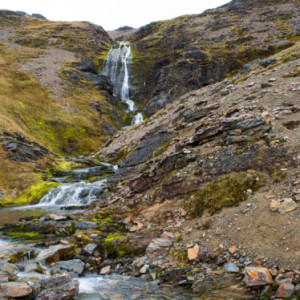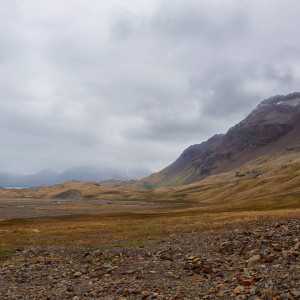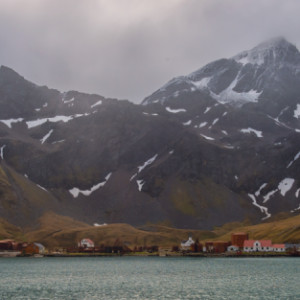Stromness and the conclusion of Shackleton's epic
We had sailed into Fortuna Bay with the plan of landing, climbing a small range and walking to Stromness following in the steps of Ernest Shackleton, Worsley and Crean on their crossing of South Georgia from King Haakon Bay to Stromness. In fact the weather closed in and it was decided it was too unsafe for us all to be tramping along the top of the ridge. As we left the Fortuna Bay to sail into Stromness there were humpbacks lunge feeding. There is something magic about them feeding. Mouthful after mouthful of krill.
We sailed into Stromness passing the old whaling station of Leith. We walked single file past the fur seals huffing and puffing at us. Really those big male fur seals need to chill. We walked up to the waterfall along a valley and at the waterfall many selfies and group shots were taken and Nina gave a talk about Shackleton’s recollections at that time. I noticed on the ridge above there was a Gentoo colony. Gee, those Gentoos are everywhere. We then walked back to the beach and ship, again single file slowing past those silly male fur seals.
We then sailed into Grytviken, another old whaling station but close to the administration centre of South Georgia at King Edward Point. There is a graveyard there where Shackleton is buried (he died on the Island of a heart attack in 1922) and then walked around to the whaling station which has a post office, wonderful museum and shop. We were given a tour by Sarah who has been working on South Georgia for 26 years. Lots of old wooden buildings and more rusting silos and equipment. It must have been such a gruesome business but apparently even though the work was hard, young men could set themselves up for life in a few years.
We were told that every part of the whale was used. The oil was most valuable and even into the late 50s and possibly 60s was used in things like margarine and ice cream. Life was hard for the men, 12 hour shifts, 6 days a week. From the records a lot of them bought cologne. It was worked out that the station manager Larsen, had banned alcohol and the men used to drink the cologne. There was a church there (lutheran design) with a library and entry book showing Shackleton’s death in 1922. There was a lovely organ and bell that rang. Larsen also provided such amusements as a cinema and ski jump! This station processed nearly 2 million whales. Frightening to think of.
And now for the conclusion of Shackleton’s story. Apologies this is a rather long entry but I feel it needs to be noted as we had been following in his footsteps more or less since we left Antarctica. Well done if you get to the end!
When Shackleton and the men arrived at King Haakon bay after their tumultuous journey, they rested a few days. He realised that the populated whaling stations lay on the north eastern coast. He decided not to make another boat journey around the island as there was a real risk that they would be taken by the currents far to the East and the condition of the James Caird was not the best. The only option was a land crossing through the unexplored interior.
After five days, the party took the boat a short distance eastwards, to the head of a deep bay which would be the starting point for the crossing. Shackleton, Worsley and Crean were to make the crossing and Vincent and McNish remained at Peggotty Camp. The Crossing party set out for Stromness which had been the last port of call of the Endurance on 19 May 1916.
Without a map, the route they chose was largely conjectural. They used nails/screws from the James Caird in their boots for crampons and a carpenters adze as an ice axe. By dawn they had ascended to 3,000 feet (910 m) and could see the coast. At the close of that first day, needing to descend to the valley below them before nightfall, they risked everything by sliding down a mountainside on a makeshift rope sledge.They travelled on by moonlight, moving upwards towards a gap in the next mountainous ridge. They had to cross many dangerous crevasses, peaks and ridges.
Early next morning, 20 May, they saw Husvik Harbour and heard the steam whistle from Stromness "the first sound created by an outside human agency that had come to our ears since we left Stromness Bay in December 1914". After a difficult descent, which involved passage down through a freezing waterfall, they at last reached safety. They staggered into the station and asked to see the manager but he didn’t recognise them. They asked first for a bath and could not sleep as the beds were too comfortable.
When recovered, Shackleton organised a rescue of the men on the West Coast and then organised the rescue the men left on Elephant Island. He brought all 28 men back home alive. A truly amazing feat.
The main blip is of Stromness as we approached it from the ship. The managers house is that small white building fifth from the left.
The extras are:
The waterfall that they slid down (not frozen now), the view from the waterfall looking back at the valley (Stromness not able to be seen but you can see the bay), Gryptviken, us at Shackleton's grave, one of the old whaling ships, the church, a replica of the James Caird in the museum. The photo really doesn't show just how small this lifeboat was.
Thank you if you have got this far, you are a trooper!




Comments
Sign in or get an account to comment.


